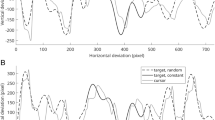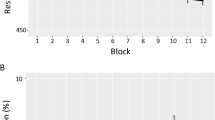Abstract
Assessing implicit learning in the continuous pursuit-tracking task usually concerns a repeated segment of target displacements masked by two random segments, as referred to as Pew’s paradigm. Evidence for segment learning in this paradigm is scanty and contrasts with robust sequence learning in discrete tracking tasks. The present study investigates this issue with two experiments in which participants (N = 56) performed a continuous tracking task. Contrary to Pew’s paradigm, participants were presented with a training sequence that was continuously cycled during 14 blocks of practice, but Block 12 in which a transfer sequence was introduced. Results demonstrate sequence learning in several conditions except in the condition that was obviously the most similar to previous studies failing to induce segment learning. Specifically, it is shown here that a target moving too slowly combined with variable time at which target reversal occurs prevents sequence learning. In addition, data from a post-experimental recognition test indicate that sequence learning was associated with explicit perceptual knowledge about the repetitive structure. We propose that learning repetition in a continuous tracking task is conditional on its capacity to (1) allow participants to detect the repeated regularities and (2) restrict feedback-based tracking strategies.





Similar content being viewed by others
References
Adams, J. A. (1961). Human tracking behavior. Psychological Bulletin, 58, 55–79.
Berry, D. C., & Broadbent, D. E. (1988). Interactive tasks and the implicit-explicit distinction. British Journal of Psychology, 79, 51–72.
Chambaron, S., Ginhac, D., Ferrel-Chapus, C., & Perruchet, P. (2006). Implicit learning of a repeated segment in a continuous tracking: A reappraisal. Quarterly Journal of Experimental Psychology, 59, 845–854.
Chambaron, S., Ginhac, D., & Perruchet, P. (2008). Is learning in SRT tasks robust across methodological variations? L’Année Psychologique, 108, 465–486.
Cleeremans, A., Destrebecqz, A., & Boyer, M. (1998). Implicit learning: News from the front. Trends in Cognitive Sciences, 2, 406–416.
Cohen, A., Ivry, R. I., & Keele, S. W. (1990). Attention and structure in sequence learning. Journal of Experimental Psychology: Learning, Memory, and Cognition, 16, 17–30.
Destrebecqz, A., & Cleeremans, A. (2001). Can sequence learning be implicit? New evidence with the process dissociation procedure. Psychonomic Bulletin & Review, 8, 343–350.
Lang, A., Gapenne, O., & Rovira, K. (2011). Questioning implicit motor learning as instantiated by the pursuit tracking task. Quarterly Journal of Experimental Psychology, 64(10), 2003–2011.
Magill, R. A. (1998). Knowledge is more than we can talk about: Implicit learning in motor skill acquisition. Research Quarterly for Exercise and Sport, 69, 104–110.
Nissen, M. J., & Bullemer, P. (1987). Attentional requirement of learning: Evidence from performance measures. Cognitive Psychology, 19, 1–32.
Perruchet, P. (2008). Implicit learning. In H. L. Roediger III (Ed.), Learning and memory: A comprehensive reference (Vol. 2, pp. 597–621). Oxford: Elsevier.
Perruchet, P., & Amorim, M.-A. (1992). Conscious knowledge and changes in performance in sequence learning: Evidence against dissociation. Journal of Experimental Psychology: Learning, Memory, and Cognition, 18, 785–800.
Perruchet, P., Chambaron, S., & Ferrel-Chapus, C. (2003). Learning from implicit learning literature: Comment on Shea, Wulf, Whitacre, and Park (2001). Quarterly Journal of Experimental Psychology, 56A, 769–778.
Perruchet, P., & Vinter, A. (2002). The self-organizing consciousness. Behavioral and Brain Sciences, 25, 297–388.
Pew, R. W. (1974). Levels of analysis in motor control. Brain Research, 71, 393–400.
Reed, J., & Johnson, P. (1994). Assessing implicit learning with indirect tests: Determining what is learned about sequence structure. Journal of Experimental Psychology: Learning, Memory, and Cognition, 20, 585–594.
Roberston, E. M. (2007). The serial reaction time task: Implicit motor skill learning? The Journal of Neuroscience, 27, 10073–10075.
Seger, C. A. (1994). Implicit learning. Psychological Bulletin, 115, 163–196.
Shanks, D. R., & Channon, S. (2002). Effects of a secondary task on ‘‘implicit’’ sequence learning: Learning or performance? Psychological Research, 66, 99–109.
Shanks, D. R., Rowland, L. A., & Ranger, M. S. (2005a). Attentional load and implicit sequence learning. Psychological Research, 69, 369–382.
Shanks, D. R., & St. John, M. F. (1994). Characteristics of dissociable human learning systems. Behavioral and Brain Sciences, 17, 367–447.
Shanks, D. R., Rowland, L. A., & Ranger, M. S. (2005b). Attentional load and implicit sequence learning. Psychological Research, 69, 369–382.
Shea, C., Wulf, G., Whitacre, C. A., & Park, J. (2001). Surfing the implicit wave. Quarterly Journal of Experimental Psychology, 54A, 841–862.
Wilkinson, L., & Shanks, D. R. (2004). Intentional control and implicit sequence learning. Journal of Experimental Psychology: Learning, Memory, and Cognition, 30, 354–369.
Wulf, G. (2007). Attentional focus and motor learning: a review of 10 years of research. E-Journal Bewegung und Training, 1, 4–14.
Wulf, G., Hoss, M., & Prinz, W. (1998). Instructions for motor learning: Differential effects of internal versus external focus of attention. Journal of Motor Behavior, 30, 169–179.
Wulf, G., & Schmidt, R. A. (1997). Variability of practice and implicit motor learning. Journal of Experimental Psychology: Learning, Memory, and Cognition, 23, 987–1006.
Wulf, G., & Shea, C. H. (2004). Understanding the role of augmented feedback: The good, the bad and the ugly. In A. M. Williams & N. J. Hodges (Eds.), Skill acquisition in sport: Research, theory and practice (pp. 121–144). London: Routledge.
Acknowledgments
We are very grateful to Peter Pfordresher, Pierre Perruchet and Richard Ivry for their valuable comments and suggestions on previous versions of this article. We also thank John Stewart for careful review of the English style of the manuscript.
Author information
Authors and Affiliations
Corresponding author
Rights and permissions
About this article
Cite this article
Lang, A., Gapenne, O., Aubert, D. et al. Implicit sequence learning in a continuous pursuit-tracking task. Psychological Research 77, 517–527 (2013). https://doi.org/10.1007/s00426-012-0460-x
Received:
Accepted:
Published:
Issue Date:
DOI: https://doi.org/10.1007/s00426-012-0460-x




